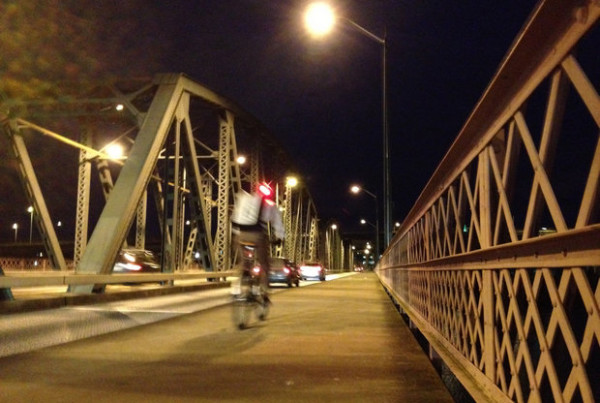AsiaOne Motoring: Be a cyclist in Singapore? No chance at all
By Tan Hui Yee, Correspondent
IT IS a sight that would make the skin of any driver crawl: A weathered old lady hurtling down the road’s fastest lane on a kamikaze bicycle ride against the flow of traffic.
Kamikaze Auntie is usually found in the central districts of Singapore. She is robust enough to ride her bike without wobbling, but old enough to give you a tongue-lashing if you dare tell her she is riding dangerously. After all, it is illegal to cycle on footpaths in Singapore, she will snarl.
Against this backdrop, drivers probably felt nothing but relief when Tampines town announced last month that it was going to be the Republic’s first cycling town. The two-wheelers would be given space on expanded footpaths so they could ride safely and legally alongside pedestrians.
But this has got some pedestrians all worked up. At work one day, I was treated to a long tirade from a colleague about the looming threat of gory deaths in Tampines as reckless cyclists mow down hapless residents.
’Look at what it is like in East Coast Park,’ she cried. ’That is what it is going to be like in Tampines.’
Singapore’s most popular seaside park is home to a whirlwind of high-speed cyclists, in-line skaters, joggers and campers. Jaw-dropping pile-ups are common there, as unsuspecting park strollers stumble into the paths of speeding skaters or cyclists.
It is true that dangerous cyclists are a hazard both on roads and on footpaths. Kamikaze Aunties aside, there are also clumsy cyclists who wobble along the road at low speed, as well as professional-looking athletes who are apt to weave from road to footpath, or vice versa, on a whim.
These cyclists stand little chance on the roads in a country known for bad driving. At least 15 cyclists lose their lives each year, many to drivers who feel that the roads belofor ing to cars – especially their car.
The fact that the Land Transport Authority has resisted calls to build proper cycling lanes is probably one of the reasons that Tampines is expanding its footpaths for cyclists.
Still, the simmering debate begs the question: Do cyclists belong on the road or the footpath?
It is an issue which no amount of finger-pointing is going to resolve, but recent road traffic experiments in Europe might hold a clue.
In the bustling Dutch town of Drachten, the authorities have removed traffic lights, road markings and some pedestrian crossings. Lane markers are absent and there are no kerbs separating the street from the pavement. It is not clear who has the right of way, nor how fast drivers can go.
Conditions which most people would presume cause anarchy have produced the opposite effect: Traffic moves smoothly as drivers slow down to gauge the intentions of cyclists and pedestrians. All parties make eye contact with each other as they negotiate their usage of the ambiguous space. In short, the street has turned out to be safer for everybody, precisely because nobody has the right of way.
The Drachten experiment may be too out of this world for a place like Singapore, where there are clear rules telling people where they can eat and how to wash their hands. But the principles that apply in Drachten could well apply – in reverse – in East Coast Park.
Traffic engineer Hans Monderman, who reworked Drachten’s roads, believes that clear lanes and street signs give drivers a false sense of security. Drivers speed down these lanes thinking there are no obstructions, which increases the severity of accidents should something catch them unawares.
According to Mr Monderman, lowering speed limits does not help if all other visual cues tell the driver that the road ahead is clear.
Which explains the pile-ups on the cycling paths in East Coast Park. The dedicated trails give cyclists the impression that they have the right of way and prompt them to throw caution to the wind.
Instead of erecting speed limit signs and slapping yet more penalties on errant cyclists, perhaps the authorities should be looking in the other direction. Perhaps the spaces – be they walking or cycling trails or secondary roads – should not be so clearly demarcated in the first place. (Note, here, that expressways are not part of this discussion, as such high-speed roads perform a key function in the transport system.)
After all, if footpaths are meant for pedestrians, and cycling paths are meant for bicycles, where should skateboarders and in-line skaters go? Where do motorised wheelchairs fit in, for that matter, or zippy two-wheel Segways, which are neither bikes nor wheelchairs?
How can the Singapore transport system accommodate a growing list of mobility gadgets in a meaningful way, without further cramping the available space we have?
Bus lanes need not exist if motorists gave way to buses on the roads. Similarly, cycling lanes would not be needed if motorists took care when overtaking them on the roads, and if cyclists themselves looked out for the safety of pedestrians in their way.
It might sound counter-intuitive, but the journey ahead could be a lot smoother if every road or path user had to learn to negotiate the space with every other user.
When the lines are fuzzy and nobody has the right of way, there could be just enough space for everybody, even Kamikaze Auntie.

